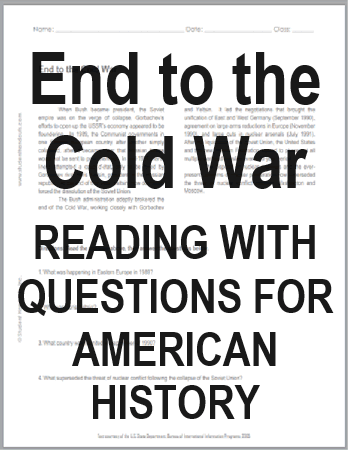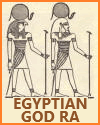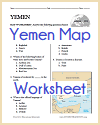| End to the Cold War Reading with Questions |
|---|
| www.studenthandouts.com ↣ American History ↣ American History Readings |
 When Bush became president, the Soviet empire was on the verge of collapse. Gorbachev's efforts to open up the USSR's economy appeared to be floundering. In 1989, the communist governments in one Eastern European country after another simply collapsed, after it became clear that Russian troops would not be sent to prop them up. In mid-1991, hard-liners attempted a coup d'etat, only to be foiled by Gorbachev rival Boris Yeltsin, president of the Russian republic. At the end of that year, Yeltsin, now dominant, forced the dissolution of the Soviet Union.
When Bush became president, the Soviet empire was on the verge of collapse. Gorbachev's efforts to open up the USSR's economy appeared to be floundering. In 1989, the communist governments in one Eastern European country after another simply collapsed, after it became clear that Russian troops would not be sent to prop them up. In mid-1991, hard-liners attempted a coup d'etat, only to be foiled by Gorbachev rival Boris Yeltsin, president of the Russian republic. At the end of that year, Yeltsin, now dominant, forced the dissolution of the Soviet Union.
The Bush administration adeptly brokered the end of the Cold War, working closely with Gorbachev and Yeltsin. It led the negotiations that brought the unification of East and West Germany (September 1990), agreement on large arms reductions in Europe (November 1990), and large cuts in nuclear arsenals (July 1991). After the liquidation of the Soviet Union, the United States and the new Russian Federation agreed to phase out all multiple-warhead missiles over a 10-year period. The disposal of nuclear materials and the ever-present concerns of nuclear proliferation now superseded the threat of nuclear conflict between Washington and Moscow. Directions: Read the text above, then answer the questions below. 1. What was happening in Eastern Europe in 1989? 2. Who was Boris Yeltsin? 3. What country was reunited in September of 1990? 4. What superseded the threat of nuclear conflict following the collapse of the Soviet Union? Click here to print this worksheet. Answers will vary. |
 |  |  |  |  |
| UNIT I: | Early America | UNIT IX: | Discontent and Reform | ||
| UNIT II: | Colonial Period | UNIT X: | War, Prosperity, and Depression | ||
| UNIT III: | American Revolution | UNIT XI: | New Deal and World War II | ||
| UNIT IV: | New National Government | UNIT XII: | Postwar America | ||
| UNIT V: | Westward Expansion | UNIT XIII: | Decades of Change | ||
| UNIT VI: | Sectional Conflict | UNIT XIV: | New Conservatism | ||
| UNIT VII: | Civil War and Reconstruction | UNIT XV: | Into the Twenty-first Century | ||
| UNIT VIII: | Growth and Transformation | UNIT XVI: | Polarization and Deglobalization |
| www.studenthandouts.com ↣ American History ↣ American History Readings |








